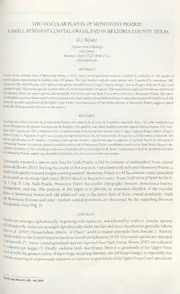
THE VASCULAR PLANTS OF MOWOTONY PRAIRIE: A SMALL REMNANT COASTAL GRASSLAND IN BRAZORIA COUNTY, TEXAS PDF
Preview THE VASCULAR PLANTS OF MOWOTONY PRAIRIE: A SMALL REMNANT COASTAL GRASSLAND IN BRAZORIA COUNTY, TEXAS
THE MOWOTONY VASCULAR OF PLANTS PRAIRIE: REMNANT SMALL COASTAL GRASSLAND A BRAZORIA COUNTY, TEXAS IN Rosen DJ. Department of Biology Lee College Baytown, Texas 77522-0818, U.SA [email protected] ABSTRACT 1 previously reported a species rich flora for Nash Prairie, a 120 ha remnant of undisturbed Texas coastal Mowotony grassland (Rosen 2007). During the course of that research, simultaneously surveyed Prairie, a I trailer but equally rich and unique coastal grassland. Mowotony Prairie is a 42 ha remnant coastal grassland o also Seated on 'W95 40 the Nash Groce (KNG) Ranch in Brazoria County, Texas (N29°16'16.0 , , 19.5"; Kittie % 1, Fig. 2). Like Nash Prairie, Mowotony Prairie has similar topographic features, disturbance history, “anagement, and The purpose paper provide an annotated checklist of the vascular use. of this to is Plants of Mowotony Texas Nash Prairie and add additional taxa to the native flora of coastal grasslands. ^ Mowotony by expanding Houston and remnant grasslands are threatened the Prairies other coastal ^tropolitan Area (Fig. 1). CHECKLIST ^lies are arranged beginning with monocots, and followed by eudicots. Genera, species, alphabetically, infraspecific names are arranged alphabetically under families and their classification generally follows & from Panicum et al. (1997). Dichanthelium (Hitchc. Chase) Gould is treated seperately L. Nativity native to the United based on Correll and Johnston (1970). Non-native species are indicated States) is an ty asterisk Native grassland taxa not reported from Nash Prairie (Rosen 2007) are indicated (*). coastal Upper ^superscript dagger 0. endemic (with distribution limited to grasslands of the Texas Finally, 0r the greatest extent of their range occurring therein), rare (of limited range), or regionally rare Wdom Upper occurring unknown occurrence in grasslands of the Texas Coast) species are or of previously 493 m 494 Journal of the Botanical Research Institute of Texas 4(1) 4432 Agalinis (Small) Pennell, viridis Buchnera americana 2598 Michx.,3275 L., Engelm, 3289 Castilleja indivisa Mecardonia acuminata (Walter) Small, 4436 fNuttallanthus texanus (Scheele) D. Sutton, 3273 Scrophulariaceae 4379 Agalinis fasciculate (Elliott) Raf., *. summary Mowotony Tabu Taxonomic of vascular plants of Prairie. 1. Total Families This research resulted in collections of 199 species of vascular plants representing 41 families and 129 gen- era (Table The four families with the most species were Poaceae (45), Asteraceae (38), Cyperaceae (30), 1). Panicum and Fabaceae Species-rich genera included Carex (7 spp.), Cyperus (8 spp.)Juncus (6 spp.), (5 (19). Non and Paspalum and Paspalum native species Cyperus haspan, Briza minor, Cynodon dactylon, spp.), (6 spp.). ( 2% number urvillei) accounted for of the total of species. Of the 195 native species that occur at Mowotony Prairie, 41 are not known from Nash Prairie (Rosen 2007). One family, Buddlejaceae, not known from Nash Prairie (Rosen 2007). The native vascular plant is and taxa reported here combined with those reported from Nash Prairie provides a documented 63 families 331 species for remnant coastal grasslands of the Upper Texas Coast. Mowotony Nine endemic, rare, or regionally rare species found at Nash Prairie also occur at Prairie: var. Juncus Cooperia traubii, Eleocharis compressa var. acutisquamata E. Scleria muehlenbergii, elliottii wolfii, , An addi- Boihriochloa exaristata, Sporobolus silveanus, Rudbeckia texana, and Thalictrum texanum. elliottii, by uplands Mowotony abundance and dominance of tional interesting characteristic of Prairie the local is Oklahoma, Texas) Sporobolus silveanus. This species is endemic to the southeastern United States (Louisiana, (Gould where grows in blackland prairies, wet to mesic pine woodlands and adjacent glades and barrens it novel North America Committee Diamond and Smeins described a S. 1975; Flora of Editorial 2003). (1985) This silveanus-Carex meadii grassland type from the northern end of the Blackland Prairie region of Texas. km was discovered same community 500 where occurrence of seemingly the or similar over south of sites it much and of its and by Diamond and Smeins might was more widespread, described (1985) indicate that it original extent has been destroyed. ACKNOWLEDGMENTS Freck- am Robert grateful to Larry Brown, Michael Palmer, and Chris Reid for reviewing this manuscript. I Conaty mann, Robert Krai, and Guy Nesom annotated difficult specimens. Special thanks to Susan and Peter Adam Young for the tireless pursuit of a means for permanent conservation of Mowotony and Nash Prairies. prepared figure 2. REFERENCES Renner. Foundation, CoftRELL, D.S. and M.C. Johnston. 970. Manual of the vascular plants ofTexas. Texas Research 1 remnant ta of Diamond, D.D. and 1985. Composition, and species response patterns Smeins. classification, F.E. grass prairies in Texas. Amer. Midi. Naturalist 13:294-308. 1
